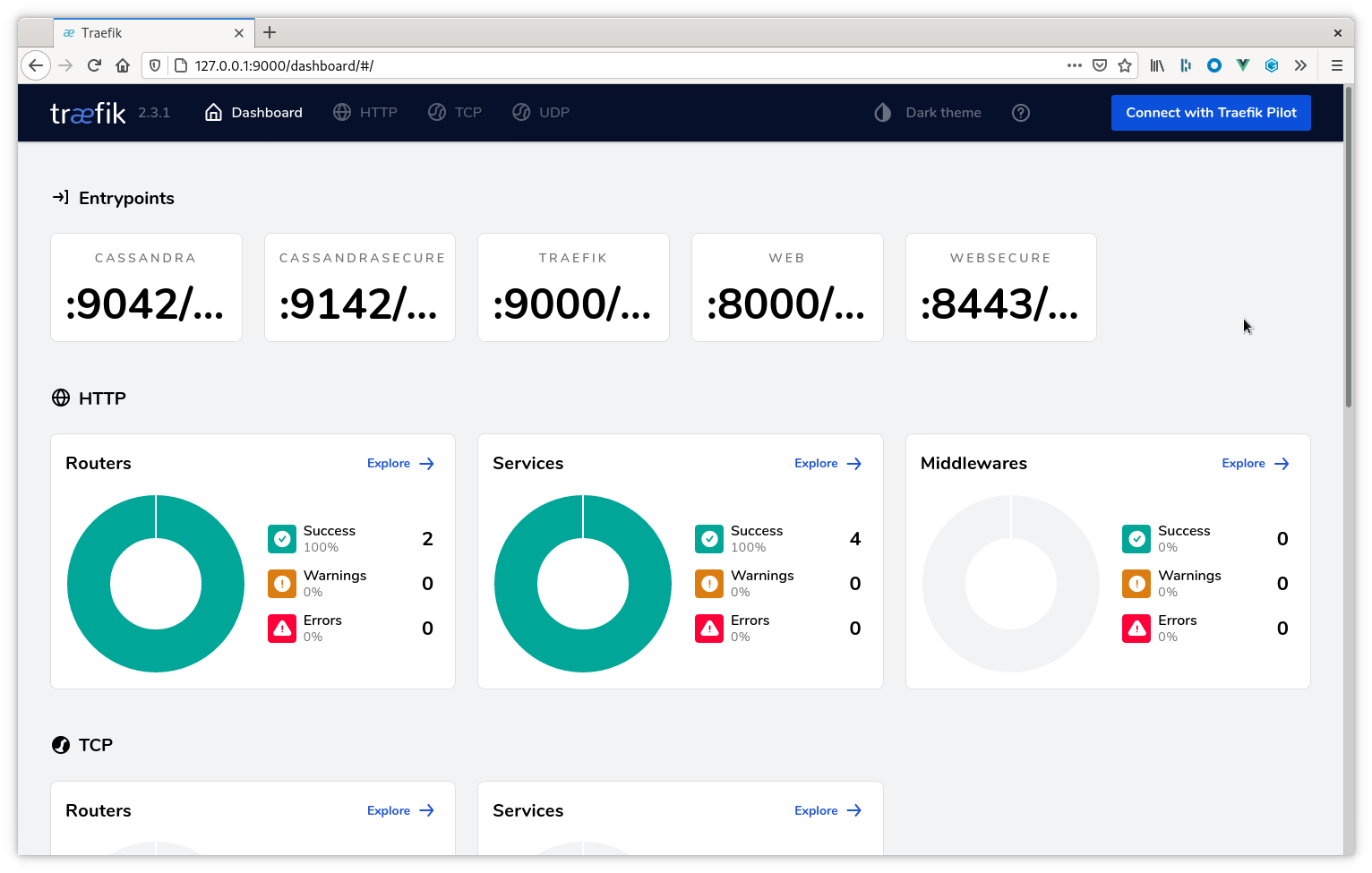Deploy K8ssandra and Traefik with Kind
When configuring Kind to use Traefik, additional configuration options are required. The following guide walks through standing up a Kind k8s cluster with Traefik configured for ingress on ports other than the standard 80 and 443.
1. Create a Kind configuration file
Kind supports an optional configuration file for configuring specific behaviors of the Docker container which runs the Kubelet process. Here we are adding port forwarding rules for the following ports:
8080- HTTP traffic - This is used for accessing the metrics and repair user interfaces8443- HTTPS traffic - Useful when accessing the metrics and repair interfaces in a secure manner9000- Traefik dashboard - WARNING this should only be done in development environments. Higher level environments should usekubectl port-forward.9042- C* traffic - Insecure Cassandra traffic. Note: Without TLS (more specifically SNI) Traefik may not be able to distinguish traffic across cluster boundaries. If you are in an environment where more than one cluster is deployed you must add additional ports here.9142- C* TLS traffic - Secure Cassandra traffic, multiple clusters may run behind this single port.8080- Stargate GraphQL API8081- Stargate Authorization REST API8082- Stargate CRUD REST API
kind.config.yaml
The kind.config.yaml file is here.
kind: Cluster
apiVersion: kind.x-k8s.io/v1alpha4
nodes:
- role: worker
- role: worker
- role: worker
- role: control-plane
kubeadmConfigPatches:
- |
kind: InitConfiguration
nodeRegistration:
kubeletExtraArgs:
node-labels: "ingress-ready=true"
extraPortMappings:
- containerPort: 32080
hostPort: 8080
protocol: TCP
- containerPort: 32443
hostPort: 8443
protocol: TCP
- containerPort: 32090
hostPort: 9000
protocol: TCP
- containerPort: 30081
hostPort: 8081
protocol: TCP
- containerPort: 30082
hostPort: 8082
protocol: TCP
- containerPort: 32091
hostPort: 9042
protocol: TCP
- containerPort: 32092
hostPort: 9142
protocol: TCP
2. Start Kind Cluster
$ kind create cluster --config ./kind.config.yaml
Creating cluster "kind" ...
✓ Ensuring node image (kindest/node:v1.18.2) 🖼
✓ Preparing nodes 📦
✓ Writing configuration 📜
✓ Starting control-plane 🕹️
✓ Installing CNI 🔌
✓ Installing StorageClass 💾
Set kubectl context to "kind-kind"
You can now use your cluster with:
kubectl cluster-info --context kind-kind
Have a question, bug, or feature request? Let us know! https://kind.sigs.k8s.io/#community 🙂
3. Create Traefik Helm values file
Note the service type of NodePort. It is used here as it is the port on the
Docker container running Kind which is forwarded to our local machine.
traefik.values.yaml
The traefik.values.yaml file is here.
---
providers:
kubernetesCRD:
namespaces:
- default
- traefik
kubernetesIngress:
namespaces:
- default
- traefik
ports:
traefik:
expose: true
nodePort: 32090
web:
nodePort: 32080
websecure:
nodePort: 32443
cassandra:
expose: true
port: 9042
nodePort: 32091
cassandrasecure:
expose: true
port: 9142
nodePort: 32092
sg-graphql:
expose: true
port: 8080
nodePort: 30080
sg-auth:
expose: true
port: 8081
nodePort: 30081
sg-rest:
expose: true
port: 8082
nodePort: 30082
service:
type: NodePort
4. Install Traefik via Helm
$ helm repo add traefik https://helm.traefik.io/traefik
$ helm repo update
$ helm install traefik traefik/traefik -n traefik --create-namespace -f traefik.values.yaml
NAME: traefik
LAST DEPLOYED: Thu Apr 22 16:59:40 2020
NAMESPACE: traefik
STATUS: deployed
REVISION: 1
TEST SUITE: None
5. Access Traefik Dashboard
With the deployment complete we may now access the Traefik dashboard at http://127.0.0.1:9000/dashboard/. Example:

Next steps
Feel free to explore other the Traefik ingress topics. Also see the additional K8ssandra tasks.
Feedback
Was this page helpful?
Glad to hear it! Please tell us how we can improve.
Sorry to hear that. Please tell us how we can improve.